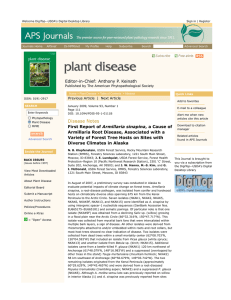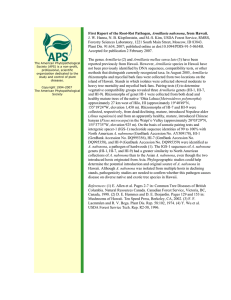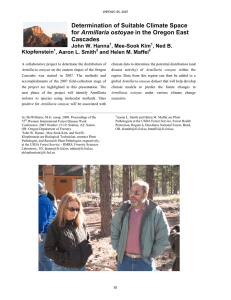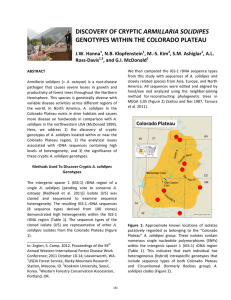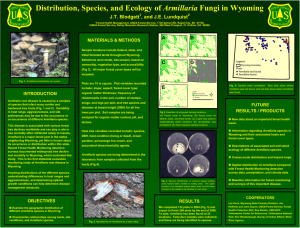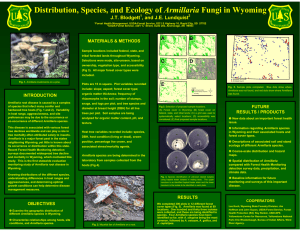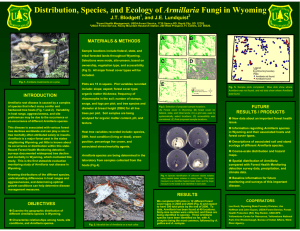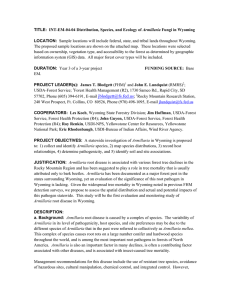January 2016, Volume 100, Number 1 7 DISEASE NOTES
advertisement
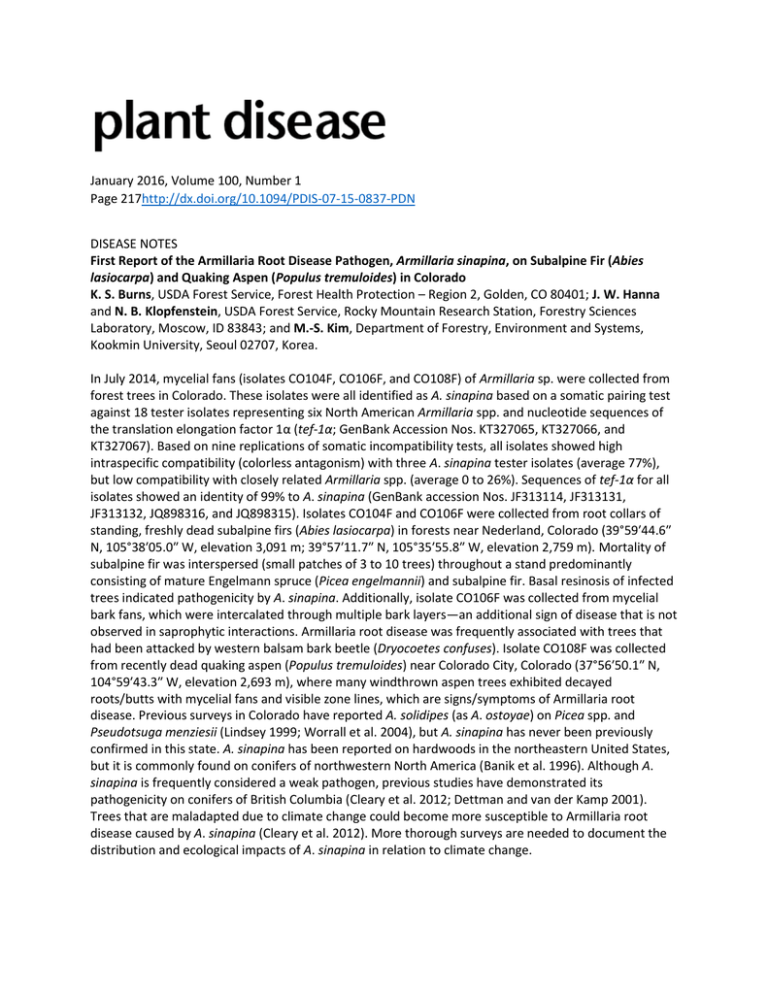
January 2016, Volume 100, Number 1 Page 217http://dx.doi.org/10.1094/PDIS-07-15-0837-PDN DISEASE NOTES First Report of the Armillaria Root Disease Pathogen, Armillaria sinapina, on Subalpine Fir (Abies lasiocarpa) and Quaking Aspen (Populus tremuloides) in Colorado K. S. Burns, USDA Forest Service, Forest Health Protection – Region 2, Golden, CO 80401; J. W. Hanna and N. B. Klopfenstein, USDA Forest Service, Rocky Mountain Research Station, Forestry Sciences Laboratory, Moscow, ID 83843; and M.-S. Kim, Department of Forestry, Environment and Systems, Kookmin University, Seoul 02707, Korea. In July 2014, mycelial fans (isolates CO104F, CO106F, and CO108F) of Armillaria sp. were collected from forest trees in Colorado. These isolates were all identified as A. sinapina based on a somatic pairing test against 18 tester isolates representing six North American Armillaria spp. and nucleotide sequences of the translation elongation factor 1α (tef-1α; GenBank Accession Nos. KT327065, KT327066, and KT327067). Based on nine replications of somatic incompatibility tests, all isolates showed high intraspecific compatibility (colorless antagonism) with three A. sinapina tester isolates (average 77%), but low compatibility with closely related Armillaria spp. (average 0 to 26%). Sequences of tef-1α for all isolates showed an identity of 99% to A. sinapina (GenBank accession Nos. JF313114, JF313131, JF313132, JQ898316, and JQ898315). Isolates CO104F and CO106F were collected from root collars of standing, freshly dead subalpine firs (Abies lasiocarpa) in forests near Nederland, Colorado (39°59′44.6″ N, 105°38′05.0″ W, elevation 3,091 m; 39°57′11.7″ N, 105°35′55.8″ W, elevation 2,759 m). Mortality of subalpine fir was interspersed (small patches of 3 to 10 trees) throughout a stand predominantly consisting of mature Engelmann spruce (Picea engelmannii) and subalpine fir. Basal resinosis of infected trees indicated pathogenicity by A. sinapina. Additionally, isolate CO106F was collected from mycelial bark fans, which were intercalated through multiple bark layers—an additional sign of disease that is not observed in saprophytic interactions. Armillaria root disease was frequently associated with trees that had been attacked by western balsam bark beetle (Dryocoetes confuses). Isolate CO108F was collected from recently dead quaking aspen (Populus tremuloides) near Colorado City, Colorado (37°56′50.1″ N, 104°59′43.3″ W, elevation 2,693 m), where many windthrown aspen trees exhibited decayed roots/butts with mycelial fans and visible zone lines, which are signs/symptoms of Armillaria root disease. Previous surveys in Colorado have reported A. solidipes (as A. ostoyae) on Picea spp. and Pseudotsuga menziesii (Lindsey 1999; Worrall et al. 2004), but A. sinapina has never been previously confirmed in this state. A. sinapina has been reported on hardwoods in the northeastern United States, but it is commonly found on conifers of northwestern North America (Banik et al. 1996). Although A. sinapina is frequently considered a weak pathogen, previous studies have demonstrated its pathogenicity on conifers of British Columbia (Cleary et al. 2012; Dettman and van der Kamp 2001). Trees that are maladapted due to climate change could become more susceptible to Armillaria root disease caused by A. sinapina (Cleary et al. 2012). More thorough surveys are needed to document the distribution and ecological impacts of A. sinapina in relation to climate change. References: Banik, M. T., et al. 1996. Mycologia 88:492. Cleary, M. R., et al. 2012. For. Pathol. 42:481. Dettman, J. R., and van der Kamp, B. J. 2001. Can. J. Bot. 79:600 Lindsey, J. P. 1999. Mycotaxon 70:99. Worrall, J. J., et al. 2004. For. Ecol. Manage. 192:191.
